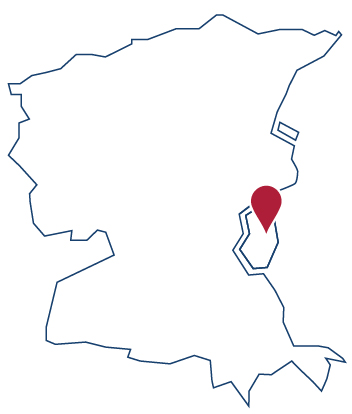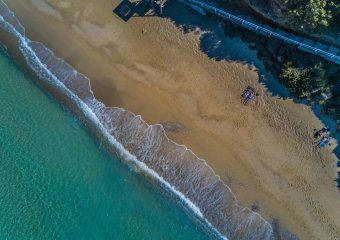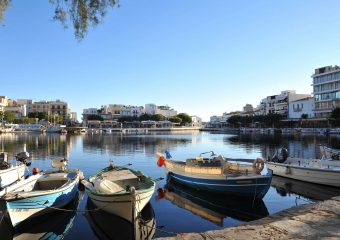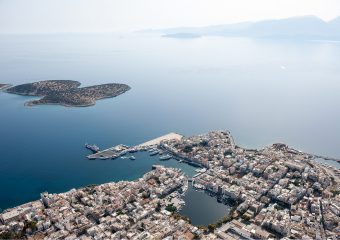Agios Nikolaos Town
An international cosmopolitan seaside resort, attracting thousands of visitors every year. The lake, the town’s jewel, is known for its many legends, according to one of which, Athena and Artemis are bathing in its waters. The lake becomes one with the sea through a narrow canal, and is surrounded by red rock formations and lush vegetation.
A stroll in the shops is always a pleasure. Stores sell unique traditional Cretan art artifacts, copies from the local archaeological museums, jewels, and impressive embroidery. They also sell local products and delicacies that dazzle everyone’s palate. The town is filled with traditional coffee shops that serve local dishes and raki.
Agios Nikolaos is equally magical at night. There are numerous bars, with a relaxed atmosphere and loud music, that attract the younger crowds. The town of Agios Nikolaos is a beautiful place with open-hearted people!
The town in figures
Agios Nikolaos took its name from the old church of Saint Nicholas, located north of the town.
Population: 12.000

Favourite
Sandy beaches
Agios Nikolaos is a seaside town, surrounded by stunning beaches. Visitors can access one of the area’s most incredibly beautiful beaches, located at a stone’s throw from downtown.
Eleftheriou Venizelou Square
Eleftherios Venizelos Square is located at the very heart of the city of Agios Nikolaos. Right in the middle of the square a war memorial pillar has been placed in honour of those who died on the battlefront. Each year, on the occasion of Greek national holidays a wreath laying ceremony takes place. The church of Agia Triada (The Holy Trinity) is located right next to the square.
Roussou Koundourou Street
It is one of the most commercial streets of the city of Agios Nikolaos and runs parallel to the main pedestrian street. It features several shops, cafeterias, offices and banks and leads from Eleftherios Venizelos Square to port. It has broad pavements with benches for people to sit and rest under the shade of its many trees, mainly pines.
28th October Street (Pedestrian Street)
The beating heart of the city! It is a beautiful pedestrian street, full of commercial shops, cafeterias, bars and bookstores. Just like Roussou Koundourou Street, it leads from Eleftheriou Venizelou Square to the port. Right next to the stairs which provide access to the lake of Agios Nikolaos there is a statue of Roussos A. Koundouros; a politician and hero of the Cretan Resistance who was executed by the Germans.
Kitroplateia
It is the most central beach of Agios Nikolaos. It is fully organized with amazing views of the mountains of Sitia. Next to the beach there are many restaurants and cafés. The beach is named after citron, a fruit that used to be an important part of the town's commercial activity.
Culture
The Archaeological Museum of Agios Nikolaos
The Archaeological Museum of Agios Nikolaos was inaugurated in 1969 and is considered one of the most significant in Crete. It houses collections of very important archaeological findings from the entire region of eastern Crete, extending from Malia to the distant Zakros. Findings are exhibited in chronological order from the Neolithic period until the end of Roman times. Its showcases include more than 1,500 pots, as well as the oldest gold and bronze findings in Crete. Due to maintenance, the museum currently houses periodic exhibitions only.
41, Konstantinou Palaiologou Street
Opening hours: 08.30 - 15.30 Monday - Sunday (Tuesday closed)
Tel. +30 28410 24943
Culture
The Folk Art Museum of Agios Nikolaos
The Folk Art Museum of Agios Nikolaos was established in 1978 by the Cultural Association of Eastern Crete. It is located in one of the busiest streets of Agios Nikolaos, next to the Tourist Information Bureau in Lake Voulismeni. The Museum houses authentic items of Cretan art and reflects the island’s old traditional life. This unique collection mainly consists of traditional textile handmade items, with incredible embroidery and designs. The Museum also houses holy icons, wooden artifacts, and manuscripts.
1, Konstantinou Palaiologou Street
Opening hours: 14.00 - 18.30
Culture
Ancient Kamara
The archaeological site of the Ancient Kamara is located in the centre of the city, right next to Roussou Koundourou Street. Several important artefacts and objects have been unearthed from the site and are now part of the collection of the Archaeological Museum of Agios Nikolaos. Research excavations continue to this day.
Religious Monuments
Agios Nikolaos in Ormos
The church of Agios Nikolaos is located in a small bay, where ships anchored during the Byzantine and Venetian periods. It is a single-aisled church with a dome, and was most probably built before the Arab conquest of Crete in 827-828. Two layers of frescoes adorn its interior walls. The oldest layer is non-iconic and dates back to the period of iconoclasm.
The church is one of the few examples of early-Byzantine architecture in Crete, and gave its name to the city of Agios Nikolaos.
Agia Triada
The Cathedral of Agia Triada is located in the center of Agios Nikolaos. It is a Byzantine, three-aisled, cruciform church with a dome. Its middle aisle is dedicated to Agia Triada, the northern to the Three Hierarchs, and the southern to the Presentation of the Virgin Mary.
Two chapels were added to the original church, mainly serving as confessionals. The church is filled with frescoes, representing two trends of Byzantine Hagiography: the Cretan and the Macedonian.
In 2001-02, a mosaic was placed on the façade of the church of Agia Triada, in the narthex of “Trimorfos”.
Panagia Vrefotrofos
This particularly elongated church dedicated to the Virgin Mary in the old part of the city of Agios Nikolaos is the result of two successive expansions to the west of the original single-aisled vaulted church. The original church and its first extension bear two layers of frescoes, of which the oldest -dating back to the early 14th century- is traced mainly in the eastern part, with scenes from Jesus and the Virgin Mary. The second layer, indicative of the so-called academic style of the second half of the 14th century, is traced only in the arch of the westernmost part of the church.



